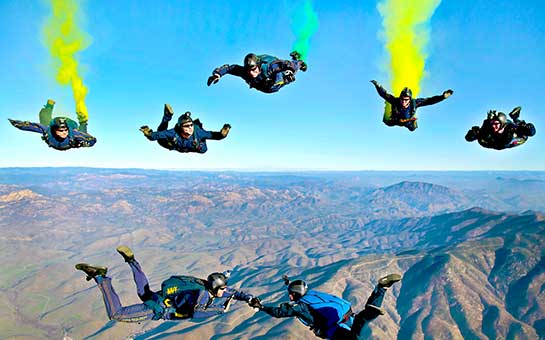Some people would be terrified at the thought of jumping out of an airplane and freefalling thousands of feet, but for others, it is the ultimate adrenaline rush.
Skydiving is as extreme as a sport can be. A whole minute of freefall miles above the ground is bound to slake your thirst for adventure.
It is a high-risk sport that only the most daring people attempt. So, it is prudent to secure yourself with sky diving insurance when skydiving. Should anything go awry, parachuting insurance could cushion you from the financial impact of medical bills.
Skydiving Insurance for Travel
Nobody likes to pay medical bills while on vacation. It is worse when it's for hazardous sports-related injuries, as the injuries sustained are usually more serious and require more intensive (and expensive) treatment. But a hazardous sports travel insurance plan will provide you with a financial safety net should the worst happen.
Basic travel insurance plans do not always cover adventure sports. To cover the added risk of hazardous sports, be sure to get an adventure sports travel insurance plan that includes skydive insurance or tandem skydive insurance (if applicable) before you make the big leap.
Skydiving Basics
There is some debate as to who invented skydiving. But the first recorded jump was in 1919 by Leslie Irvin. Both the parachute and harness were much improved during WWII, and the sport became popular around the 1950s.
The highest recorded skydive was from an absurd height of 128,000 feet (about 39,000 meters) But most enthusiasts jump from 10,000 feet (about 3,000 meters) to 14,000 feet (about 4,250 meters), which is still quite risky.
Both your harness and parachute play a paramount role in skydiving. You need to double-check and optimize your gear to your body weight and structure. A loose strap or a buckle can result in severe injury when you pull the ripcord for your parachute.
You will need a license to skydive solo, but if you are a beginner, you can opt for tandem skydiving. In tandem skydiving, an instructor will skydive with you in a tandem harness. The risks of tandem diving are considerably less. However, you will still need to follow your guide's instructions carefully, as any mistake can result in a disaster for both of you.
It is easy to get lost in that floating sensation of freefall. But you need to be attentive and focused to know when to pull the parachute cord. Pulling too early can cause you to get blown far off-course, and pulling too late can end in a painful crash landing.
Skydiving is undoubtedly a risky extreme sport. You need a clear head and foolproof gear to attempt it, but even then, unpredictable weather conditions can result in disaster. It is best to prepare for every eventuality with a hazardous sports travel insurance plan.
Risks of Skydiving
The injuries sustained in skydiving accidents are usually quite severe. Malfunctions in your harness and parachute can result in joint and limb dislocations. High-speed impact with both water and land can cause broken bones, internal hemorrhaging, and a severe concussion.
Although you will hear that unpredictable and severe weather conditions can result in accidents, most of the injuries incurred through skydiving happen due to the inexperience of skydivers. If you check your equipment thoroughly and follow your instructor’s advice, then the risks are much reduced.
The fatality rate of skydiving is low, at roughly 0.0007%. However, the injuries sustained can require extensive and expensive medical treatment. Therefore, skydiving insurance or tandem skydiving insurance is recommended for all participants.
